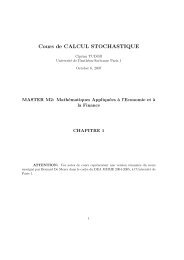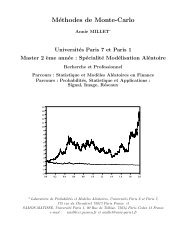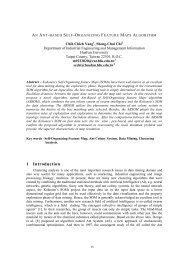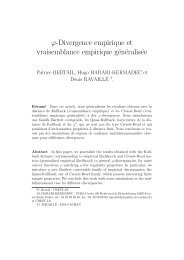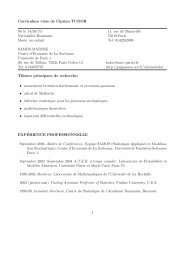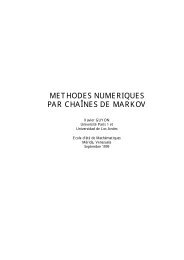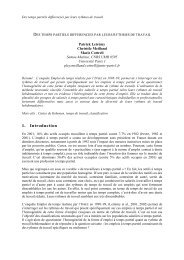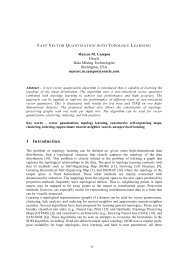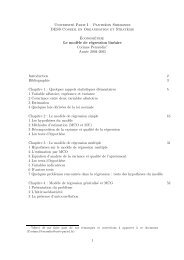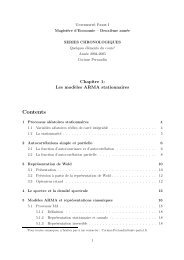Parameter estimation for stochastic equations with ... - samos-matisse
Parameter estimation for stochastic equations with ... - samos-matisse
Parameter estimation for stochastic equations with ... - samos-matisse
You also want an ePaper? Increase the reach of your titles
YUMPU automatically turns print PDFs into web optimized ePapers that Google loves.
we illustrate how to treat them. For A 2 (t, s) write<br />
Since<br />
∫<br />
A 2 (t, s) = c α,β t α− 1 1<br />
t<br />
2 s 2 −β t 1 2 −α − v 1 2 −α<br />
b(X t,s )<br />
dv<br />
0 (t − v) α+ 1 2<br />
+c α,β t α− 1 2 s<br />
1<br />
2 −β ∫ t<br />
=: A 21 (t, s) + A 22 (t, s).<br />
∫ t<br />
0<br />
0<br />
b(X t,s ) − b(X v,s )<br />
dv<br />
(t − v) α+ 1 2<br />
t 1 2 −α − u 1 2 −α<br />
dv = c<br />
(t − v) α+ 1 α,β t 1−2α ,<br />
2<br />
the summand A 21 (t, s) is clearly almost surely finite using condition (C1). The second<br />
summand A 22 can be bounded as follows: <strong>for</strong> ε small enough,<br />
[ ] ∫<br />
|A 2,2 (t, s)| ≤ c α,β t α− 1 1<br />
2 s 2 −β |Xt,s − X v,s | t<br />
sup<br />
(t − v) α−ε u 1 2 −α (t − v) − 1 2 −ε dv<br />
v≤t<br />
By the Fernique theorem the supremum above has exponential moments. So, it<br />
follows that the Novikov criterium is satisfied. Let us study now the term A 4 (t, s).<br />
It is not difficult to see that the expression<br />
I = t 1 2 −α s 1 2 −β b(X t,s ) − v 1 2 −α s 1 2 −β b(X v,s )<br />
−t 1 2 −α u 1 2 −β b(X t,u ) + u 1 2 −α u 1 2 −β b(X v,u )<br />
0<br />
can be written as<br />
I =<br />
(<br />
t 1 2 −α − u 1 −α) 2 b(X t,s )<br />
(s 1 2 −β − v 1 −β) 2<br />
(<br />
+ t 1 2 −α − u 1 −α) 2 v 1 −β( )<br />
2 b(X t,s ) − b(X t,v )<br />
(<br />
+u 1 2 −α s 1 2 −β − v 1 −β) ( )<br />
2 b(X t,s ) − b(X u,s )<br />
+u 1 2 −α v 1 −β( )<br />
2 b(X t,s ) − b(X t,v ) − b(X u,s ) + b(X u,v ) .<br />
This gives a decomposition of the term A 4 (t, s) in four summands; The first three<br />
summands can be handled by using similar arguments to those already used throughout<br />
this proof. For the last term actually we need to assume the linearity of the<br />
function b (and obviously the solution of (3.1) is then Gaussian). If b is linear, then<br />
b(X t,s ) − b(X t,u ) − b(X v,s ) + b(X v,u )<br />
= X t,s − X t,u − X v,s + X v,u<br />
=<br />
∫ t ∫ s<br />
v u<br />
X b,a dbda + W α,β ((z, z ′ ])<br />
10



